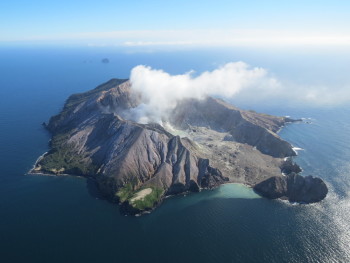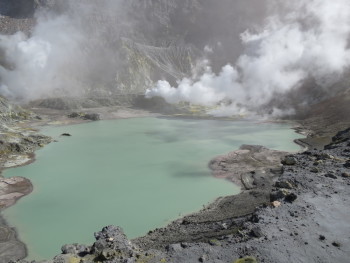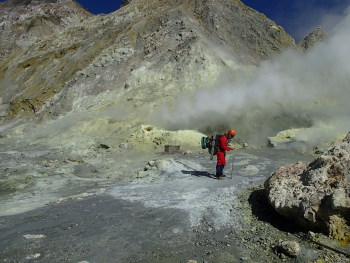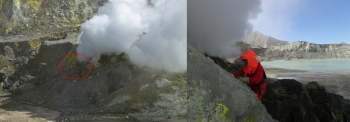
Whakaari cools down
Declining activity has allowed the GeoNet scientists to access the active crater area for the first time since late 2015. We have been able to sample the Crater Lake and gas from the active vents.
Over the last couple of weeks we have made several trips to the volcano Whakaari (White Island). Since conditions have stabilised in the active crater we could access and sample the Crater Lake for the first time since late 2015. More excitingly, for the first time ever we have been able to sample energetic fumaroles inside the crater, including those on the lava dome that grew during the 2012 eruptions. We have also completed our repairs to the solar arrays damaged by the cyclones last autumn, and made a deformation survey.
On 27 April 2016 a very explosive eruption occurred from the active crater area. The eruption threw out the Crater Lake and excavated the lake floor about 13 m. The explosive blast generated by the eruption travelled across the Main Crater floor. The blast sheared off or buried survey pegs and markers we use. The tourist trails were obscured by the eruption deposits. Further mild ash eruptions followed in September 2016.
For about a year after the April 2016 eruption, water was sitting ponded in depressions and in small craters on the crater floor, however only since April this year has there been a stable lake. While we are now comfortable to call this a ‘new’ crater lake, it is quite different from past lakes. The most noticeable difference is the temperature, which last week was only 20 ˚C; in the past, a temperature of 30-70 ˚C has been typical. Our chemical analyses of a sample collected in late July, shows that the concentration of most ‘volcanic elements’ in the lake water is the lowest for 10 or even 15 years. This is because there are few volcanic gases and liquids entering the lake; this lake is mostly formed by rainfall and run-off. While the lake is now very ‘dilute’, it is still as acidic as battery acid, so you wouldn’t want to drink it or swim in it!
In November-December 2012 a lava extrusion occurred on the active crater floor that created a small lava ‘dome’. Thermal infra-red measurements at that time indicated gases escaping the fumaroles had a temperature more than 450˚C. Following the 2016 eruptions the temperature had declined to 330˚C and has continued to decline during 2017. It is now only 114˚C, although the gas flux remains moderate and vigorous. Due to the declining activity we have been able to access and sample these. Fumarole ‘0’, a very accessible high temperature gas vent, and one that many tourists to the island visit, is also declining in temperature and is now only 152˚C down from highs over 190˚C in late 2016.
We have also re-established our survey networks damaged or destroyed by the April 2016 eruption and are now establishing trends in those data. Following the 2016 eruption there was subsidence of the Main Crater floor, which has now declined or stopped. The soil gas surveys suggest little change in gas flux.
The recent observations and measurements indicate the level of volcanic unrest is declining. This reduction in activity is however creating a new opportunity for us to collect data we couldn’t before, especially about the gases in the active crater. These data, along with our more traditional data, confirm volcanic unrest is still present and Whakaari remains an active volcano.



